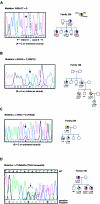Germline BHD-mutation spectrum and phenotype analysis of a large cohort of families with Birt-Hogg-Dubé syndrome
- PMID: 15852235
- PMCID: PMC1196440
- DOI: 10.1086/430842
Germline BHD-mutation spectrum and phenotype analysis of a large cohort of families with Birt-Hogg-Dubé syndrome
Abstract
Birt-Hogg-Dubé syndrome (BHD), a genodermatosis characterized by multiple hamartomas of the hair follicle (fibrofolliculoma), predisposes individuals to an increased risk of developing renal neoplasms and spontaneous pneumothorax. Previously, we localized the BHD locus (also known as FLCN) to chromosome 17p11.2 by linkage analysis and subsequently identified germline mutations in a novel gene in probands from eight of the nine families with BHD in our screening panel. Affected members of five of the families inherited an insertion/deletion of a cytosine in a C8 tract in exon 11. This mutation was also identified by exon 11 screening in probands from 22 of 52 additional families with BHD and therefore represents a hypermutable "hotspot" for mutation in BHD. Here, we screened the remaining 30 families from this large BHD cohort by direct sequence analysis and identified germline BHD mutations in 84% (51/61) of all families with BHD recruited to our study. Mutations were located along the entire length of the coding region, including 16 insertion/deletion, 3 nonsense, and 3 splice-site mutations. The majority of BHD mutations were predicted to truncate the BHD protein, folliculin. Among patients with a mutation in the exon 11 hotspot, significantly fewer renal tumors were observed in patients with the C-deletion than those with the C-insertion mutation. Coding-sequence mutations were not found, however, in probands from two large families with BHD whose affected members shared their family's BHD-affected haplotype. Of the 53 families with BHD whose members inherited either a germline mutation or the affected haplotype, 24 (45%) had at least one member with renal neoplasms. Three families classified with familial renal oncocytoma were identified with BHD mutations, which represents the first disease gene associated with this rare form of renal neoplasm. This study expands the BHD-mutation spectrum and evaluates genotype-phenotype correlations among families with BHD.
Figures



References
Electronic-Database Information
-
- Calculation of Fisher’s Exact Test, http://www.unc.edu/~preacher/fisher/fisher.htm
-
- GenBank, http://www.ncbi.nlm.nih.gov/Genbank/ (for FLCN, or BHD [accession number AF517523; Ref Seq NM_144997], skin melanoma [BC015725 and BC015687], and BAC clone RP11-45M22 [accession number AC055811])
-
- Online Mendelian Inheritance in Man (OMIM), http://www.ncbi.nlm.nih.gov/Omim/ (for BHD and FLCN)
References
-
- Binet O, Robin J, Vicart M, Ventura G, Beltzer-Garelly E (1986) Fibromes perfolliculaires, polypose colique familaile, pneumothorax spontanes familiaux. Ann Dermatol Venereol 113:928–930
-
- Birt AR, Hogg GR, Dubé WJ (1977) Hereditary multiple fibrofolliculomas with trichodiscomas and acrochordons. Arch Dermatol 113:1674–1677 - PubMed
-
- Chung JY, Ramos-Caro FA, Beers B, Ford MJ, Flowers F (1996) Multiple lipomas, angiolipomas, and parathyroid adenomas in a patient with Birt-Hogg-Dubé syndrome. Int J Dermatol 35:365–367 - PubMed
-
- Hornstein OP (1976) Generalized dermal perifollicular fibroma with polyps of the colon. Hum Genet 33:193–197 - PubMed
Publication types
MeSH terms
Substances
Associated data
- Actions
Grants and funding
LinkOut - more resources
Full Text Sources
Other Literature Sources
Medical
Molecular Biology Databases

